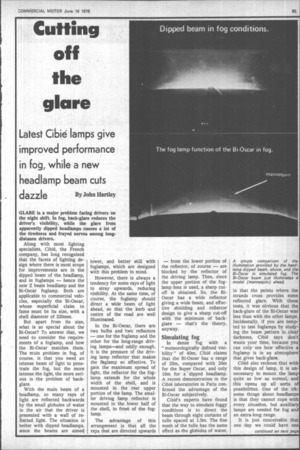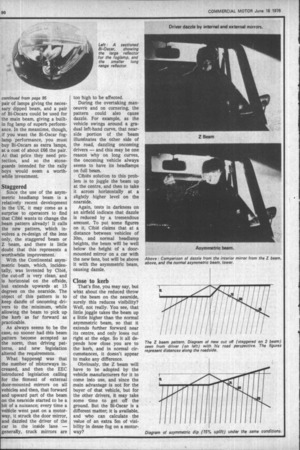Cutting off the glare
Page 97

Page 98

If you've noticed an error in this article please click here to report it so we can fix it.
Latest Cibie lamps give improved performance in fog, while a new headlamp beam cuts
dazzle By John Hartley GLARE is a major problem facing drivers on the night shift. In fog, back-glare reduces the driver's visibility, while the glare from apparently dipped headlamps causes a lot of the tiredness and frayed nerves among distance drivers.
Along with most lighting specialists, Cibie, the French company, has long recognised that the facets of lighting design where there is most scope for improvements are in the dipped beam of the headlamp, and in foglamps — hence the new Z beam headlamp and the Bi-Oscar foglamp. Both are applicable to commercial vehicles, especially the Bi-Oscar, whose superficial claim to fame must be its size, with a she'll diameter of 220mm.
But apart from its size, what is so special about the Bi-Oscar? To answer that, we need to consider the requirements of a foglamp, and how the Bi-Oscar matches them. The main problem in fog, of course, is that you need an intense beam of light to penetrate the fog, but the more intense the light, the more serious is the problem of backglare.
With the main beam of a headlamp, so many rays of light are reflected backwards by the small globules of water in the air that the driver is presented with a wall of reflected light. The situation is better with dipped headlamps, since the beams are aimed lower, and better still with foglamps, which are designed with this problem in mind.
However, there is always a tendency for some rays of light to stray upwards, reducing visibility. At the same time, of course, the foglamp should direct a Wide beam of light ahead, so that the kerb and centre of the road are well illuminated.
In the Bi-Oscar, there are two bulbs and •two reflectors — one for the foglamp and the other for •the long-range driving lamps—and oddly enough, it is the pressure of the driving lamp reflector that makes the fOglamp so effective. To gain the maximum spread of light, the reflector for the foglamp extends for the whole width of the shell, and is mounted in the rear upper portion of the damp. The smaller driving lamp reflector is mounted in the lower half of the shell, in front of the foglamp.
The advantage of this arrangement is that all the rays that are directed upwards — from the lower portion of the reflector, of course — are blocked by the reflector of the driving lamp. Then, since the upper portion of the foglamp lens is used, a sharp cutoff is obtained. So, the BiOscar has a wide reflector giving a wide beam, and effective shielding and reflector design to give a sharp cut-off with the minimum of backglare — that's the theory, anyway.
Simulating fog
In dense fog with a "meteorologically defined visibility" of 40m, Cibie claims that the Bi-Oscar has a range of 25m, compared with 20m for the Super Oscar, and only 10m for a dipped headlamp. A recent demonstration in the Cibie laboratories in Paris confirmed the advantage of the Hi-Oscar subjectively.
Cibie's experts have found that the way to simulate foggy conditions is to direct the beam 'through eight curtains of tulle spaced at 1.5m. The fine mesh of the tulle has the same effect as the globules of water, A simple comparison of the illumination provided by the headlamp dipped beam, above, and the Si-Oscar in simulated fog. The Si-Oscar beam just illuminates a model (mannequin) ahead.
in that the points where the strands cross provides some reflected glare. With these tests, it was obvious that the back-glare of the Bi-Oscar was less than with the other lamps. Incidentally, if you are tempted to test foglamps by studying the beam pattern in clear darkness, Cibie says don't waste your time, because you can only see how effective a foglamp is in an atmosphere that gives back-glare.
Cibie also reckons that with this design of lamp, it is unnecessary to mount the lamp quite as low as normal, and this opens up all sorts of possibilities. One of the irksome things about headlamps is that they cannot cope with every situation, but auxiliary lamps are needed for fog and an extra-long range.
It is just conceivable that one day we could have one
continued on next page
continued from page 95
pair of lamps giving the necessary dipped beam, and a pair of Bi-Oscars could be used for the main beam, giving a builtin fog lamp of superb performance. In the meantime, though, if you want the Bi-Oscar foglamp performance, you must buy I3i-Oscars as extra lamps, at a cost of about £66 the pair. At that price they need protection, and so the stoneguards intended for the rally boys would seem a worthwhile investment.
Staggered
Since the use of the asymmetric headlamp beam is a relatively recent development in the UK, it may come as a surprise to operators to find that Cibié wants to change the . beam pattern already! It calls ; the new pattern, which involves a re-design of the lens only, the staggered beam or Z beam, and there is little doubt that this represents a worthwhile improvement.
With the Continental asymmetric beam, which, incidentally, was invented by Cibie, the cut-off is very clean, and is horizontal on the offside, but extends upwards at 15 degrees on the nearside. The object of this pattern is to keep dazzle of oncoming drivers to the minimum, while allowing the beam to pick up the kerb as far forward as practicable.
As always seems to be the case, no sooner had this beam pattern become accepted as the norm, than driving patterns, and new legislation altered the requirements.
What happenefl was that the number of motorways increased, and then the EEC introduced legislation calling for the fitment of external door-mounted mirrors on all vehicles and then, that forward and upward part of the beam on the nearside started to be a bit of a nuisance; every time a vehicle went past on a motorway, it struck the door mirror, and dazzled the driver of the car in the inside lane — generally, truck mirrors are too 'high to be affected.
During the overtaking manoeuvre and on cornering, the pattern could also cause dazzle. For example, as the vehicle swings around a gradual left-hand curve, that nearside portion of the beam illuminates the other side of the road, dazzling oncoming drivers — and this may be one reason why on long curves, the oncoming vehicle always seems to •have its headlamps on full beam.
Cibies solution to this problem is to joggle the beam up at the centre, and then to take it across horizontally at a slightly higher level on the nearside.
Again, tests in darkness on an airfield indicate that dazzle is reduced by a tremendous amount. To put some figures on it, Cibie claims that at a distance between vehicles of 30m, and normal headlamp heights, the beam will be well below the height of a doormounted mirror on a car with the new lens, but will be above it with the asymmetric beam, causing dazzle.
Close to kerb
That's fine, you may say, but what about the reduced throw of the beam on the nearside, surely this reduces visibility? Well, not really. You see, that little joggle takes the beam up a little higher than the normal asymmetric beam, so that it extends further forward near its centre, and only loses out right at the edge. So it all depends how close you are to the kerb, and in normal circumstances, it doesn't appear to make any difference.
Obviously, the Z beam will have to be adopted by the vehicle manufacturers 'for it to come into use, and since the main advantage is not for the buyer of that vehicle, but for the other drivers, it may take some time to get off the ground. But the Bi-Oscar is a different matter; it is available, and who can calculate the value of an extra 5m of visibility in dense fog on a motorway?












































































































































































